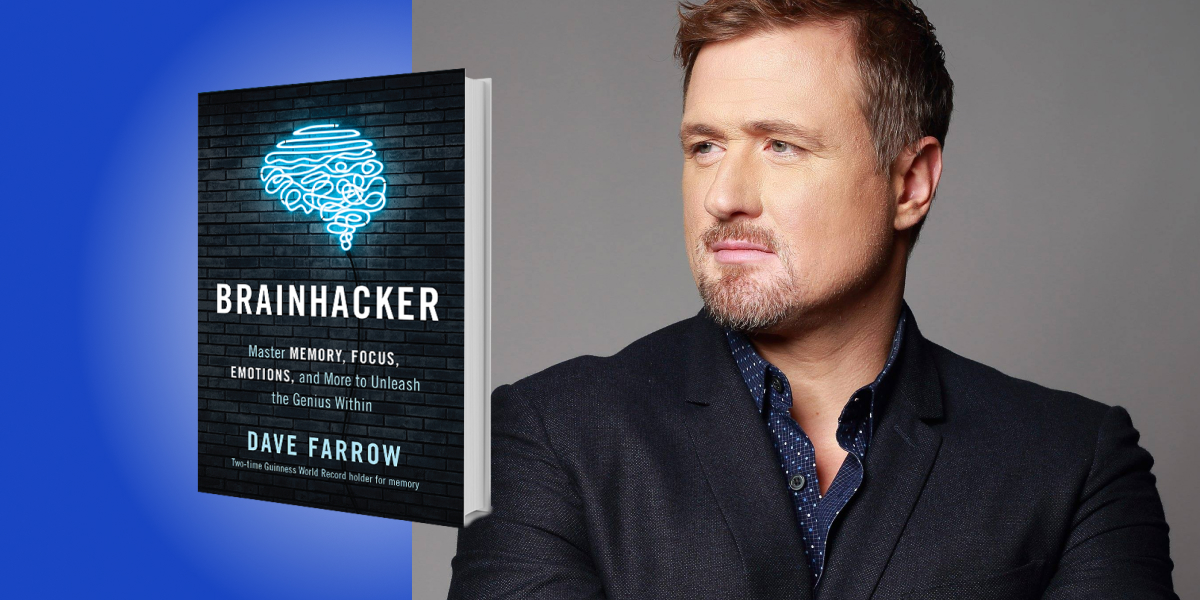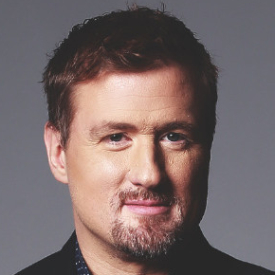Dave Farrow is the two-time Guinness World record holder for Most Decks of Playing Cards Remembered in a Single Sighting, as well as an entrepreneur, speaker, and memory coach.
Below, Dave shares five key insights from his new book, Brainhacker: Master Memory, Focus, Emotions, and More to Unleash the Genius Within. Listen to the audio version—read by Dave himself—in the Next Big Idea App.

1. The brain follows the body.
Things like movement and posture affect our brains more than we can possibly imagine. If you took a moment right now to stand up and hold your shoulders back, chin up, breathe deeply through your stomach, and look forward as if you know exactly what you’re doing, then you would actually be confident and have lots of self-esteem. Actors are so good at fooling us because they’re able to do this on a whim.
Now, what’s happening here is your brain associates all the movements of your body to everything else that’s going on. If you’re depressed, then your body matches that: you look down, slump your shoulders, breathe shallow. One of the quickest ways to change your mood is changing your posture.
Also, quite literally, the direction you point your eyes affects your brain. Did you know that when you’re trying to recall something, your natural state is to look up? Have you ever had somebody ask you for directions and your eyes kind of roll into the back of your head and you look up to the sky while you answer? In that moment, you’re accessing a larger part of your brain. According to functional MRI machines (fMRIs), we can access more of our cerebral cortex and memory when we look up. We don’t know why this is, but it seems as though the brain responds to the direction our eyes point.
2. The body also follows the brain.
People can visualize things and this affects how your brain perceives the world. For example, in my workshops, with about a hundred participants, I would get everybody to stand up and put their feet very close together, toes and heels touching. Then I would ask them to close their eyes and visualize themselves on top of a building. Slowly, very gently, they would start walking to the edge of the building and I would imply that they’re going to either jump or fly off. At that moment when they were at the edge, in their mind’s eye, many people lost their balance. We had people fall over, lean, and rock back and forth.
“Whatever you visualize, on some level your brain thinks it’s really happening.”
We knew logically that everybody was standing squarely on the ground, but brains are not logical in that sense. Whatever you visualize, on some level your brain thinks it’s really happening. This provides a great hack for dealing with pain. I’ve dealt with chronic pain for most of my life. I had to walk using a cane as a teenager, for example. The following technique saved me during a lot of those tough times.
One of the ways you can block out pain is by visualizing it and then visualizing it going away. For example, say you have a headache. Visualize your head, visualize your brain, visualize all the blood flowing, and then find some way to visualize the pain. I used to visualize it like a cloud of red dust. I would imagine the wind blowing at that cloud and, slowly but surely, I could blow that pain away. Just as the visualization started pushing that pain away, I felt the pain literally go away. I was able to block out pain for hours or days, just by using the power of my mind.
3. The power of visualization.
Anything you construct in your mind’s eye—sights, smells, sounds—on some level, your brain thinks actually happened. This is because it goes through the same pathways that the real information goes through. When you visualize information, the same parts of the brain light up, even parts of your optic nerve can light up, meaning the nerves behind your eyeballs. For the longest time, people thought we had to actually see something for those optic nerves to activate.
One powerful brain hack is called the disgust hack. This is a hack to get you to stop thinking about or craving a specific food. I used to have a tremendous obsession with Wendy’s Frosties. I was getting incredibly overweight, eating one a day. I had to find a hack to get rid of it from my brain. So, I visualized every day for a week, a couple times a day, eating a Wendy’s Frosty in some sort of disgusting way. I would imagine hair in the Frosty or bugs crawling around it.
“To this day, I haven’t had a Wendy’s Frosty, and it’s been about seven years.”
Lo and behold, I didn’t even need that whole week to visualize it. Soon I was disgusted by the idea of this food. To this day, I haven’t had a Wendy’s Frosty, and it’s been about seven years. It’s really powerful. Do not do this hack unless you really don’t want to eat that food anymore. I’ll add that it doesn’t affect similar foods. I still eat ice cream and milkshakes. Something associated with so much pleasure can be changed by your brain to be disgusting, and it works.
4. The brain is a comparison machine.
Your brain is constantly comparing everything you experience to everything else you experience. One of the interesting ways that people use this is in speed reading. You might not realize that speed is a relative concept. Have you ever been driving on the highway and then pull off onto a side street and all of a sudden it feels like you’re crawling along? The speedometer reads at a reasonable pace, but it’s very slow compared to how fast you drove moments before.
This same principle is what batters use in baseball when they try swinging a heavy bat right before getting up to the plate to hit the ball. This tricks the body into putting out more effort into the swing with the actual bat because the brain thinks it’s going to have to swing that big heavy one. Once you switch bats, your brain is still comparing it to that old weight. When you swing with the regular bat, you get 30 – 40 percent more power.
Most emotions, especially extreme emotions, go crazy because we are comparing ourselves to other people and other expectations and other situations. The stoics from ancient times believed it was important to stop comparing our experiences to every other experience. This is especially important in the age of social media, where almost every post looks like the best day ever. We should accept the good with the bad. We realize that there’s roughly 50 percent good and 50 percent bad; both come in equal measure to just about everybody in life. This understanding can really calm emotions.
“The stoics from ancient times believed it was important to stop comparing our experiences to every other experience.”
This happens all the time in group therapy. If you’re in a group where you’ve experienced something that everyone else in the group has experienced, people enter the group feeling extreme emotions, but once they encounter other people who have had the same experience, they realize that their experience isn’t unique. They’re not special in a bad way, life is not against them. Knowing that other people have had that experience lowers our stress and helps us relax.
5. Live life on purpose.
One of my greatest quotes from the amazing philosopher Dolly Parton (and yes, I think she’s a philosopher) is to find out who you are and to do it on purpose. I firmly believe that. Society needs to believe that we can change. When I was growing up, there were two schools of thought when it came to the brain. There was the brain plasticity school of thought and the hardwired model. At the time, most people didn’t believe in brain plasticity. Most scientists thought it was very fringe. The idea that the brain could change itself over time was just not accepted. The consensus in the scientific community was that your brain is hardwired after a certain age, for the rest of your life.
This belief was responsible for some terrible public policies. There’s something called the Three Strikes Rule that came about during the Clinton administration based entirely on this hardwired brain model where if you committed three crimes of a certain extent, they basically lock you up and throw away the key. Things like this, as well as mandatory minimums, were based entirely on the scientific consensus about the brain. It’s led to our mass incarceration and overpopulation in prisons today.
Take this to the education system. The education system that believed in the hardwired model failed for thousands of kids until they finally realized that you can believe in change. When you create a society that believes in change and redemption, the results are amazing. People who come back from war after a brain injury can train their brains and regrow new systems. Now there are recovery treatments for people who have experienced a stroke.
Amazing things have also happened in everyday life. You are not too old, you are not too set in your ways, and you’re not too smart to learn something new or challenge your current beliefs. Hack your brain to get the life that you want, because you don’t have to be stuck with what you believe you were born with. Your brain can change, and you can be in charge of it.
To listen to the audio version read by author Dave Farrow, download the Next Big Idea App today:































